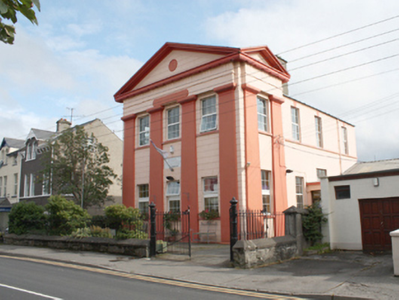Survey Data
Reg No
40815072
Categories of Special Interest
Architectural
Previous Name
Scoil Gairm-Oidis Buncrannaighe
Original Use
Gentlemens club
Historical Use
School
In Use As
Building misc
Date
1900 - 1940
Coordinates
234478, 431919
Date Recorded
12/09/2008
Date Updated
--/--/--
Description
Detached three-bay two-storey gable-fronted former technical school, built c. 1925, having Doric-style pedimented entrance front to north, and pedimented bays to the north end of each side elevation (east and west). Possibly originally built as a gentlemen’s club or as a Masonic hall in 1908. In use as a technical school from c. 1945 at the latest. Now in use as an adult education and training centre with modern additions to the rear (south) and to the east and west elevations. Four bay elevations to sides (east and west). Pitched artificial slate roof with rendered chimneystack to the west pitch, some surviving sections of cast-iron rainwater goods, and with moulded render coping\cornice over pediments entrance front (north) and to the north bay to the side elevations (east and west). Channelled smooth rendered walls to the entrance front having engaged Doric-style pilasters to corners and flanking central bay supporting entablature over with triglyphs and guttae to frieze and mutules to cornice, and with moulded pediment over having channelled smooth rendered walls to tympanum with central roundel motif. Channelled smooth rendered walls to the north bay to side elevations (eat and west) having engaged Doric-style pilasters to flanking window opening supporting entablature over with triglyphs and guttae to frieze and mutules to cornice, and with moulded pediment over having channelled smooth rendered walls to tympanum, Smooth rendered walls elsewhere. Square headed window openings with replacement windows. Continuous sill courses to side elevations at first floor level. Modern porch to the west elevation having modern glazed doors and sidelights. Set slightly back from road to the west of the centre of Buncrana. Low rendered rubble stone boundary walls to road-frontage to the north having rendered coping and cast-iron railings over. Gateway to the north-west of site having a pair of decorative cast-iron gate posts with cast-iron double gates.
Appraisal
This unusual building, of early-to-mid twentieth century date, retains much of its early character and form despite recent alterations and the construction of numerous extensions to accommodate new use(s). Of particular note is the elaborate and well-detailed Doric-style entrance front to north with pronounced pediment over, and with triglyphs and guttae to frieze. The north bay to both the side elevations (east and west) is afforded similar treatment. However, this entrance block screens much more prosaic and plain elevations to the sides and rear. According to local information, this building was originally constructed as a gentlemen’s club at the start of the twentieth century. It may have been originally built as a Masonic hall in 1908 to designs by the architect Thomas Johnston (b. 1861): a new Masonic hall was built somewhere around here at this time replacing an earlier hall (extant in 1902) adjacent immediately to the north of this building. The fine cast-iron gates and railings to the northern boundary of the site would be unusual to find with a building constructed during the mid-twentieth century, which hints at an earlier date. This building was later in use as a technical school from 1945 at the latest (possibly as early as 1925 when Buncrana Technical School was originally established) until 1982 when a modern school building was constructed in Buncrana. Alterations may have taken place here (‘alterations and new furniture’ IIA) in 1946, which were carried out by the architect Charles McLaughlin. Although extended and altered, this imposing building it its classical entrance front is an interesting addition to the built heritage of Buncrana, its monumentality and detailing making it a significant part of the streetscape to the west of the town centre. The good-quality cast-iron gates, gate posts and railings add significantly to the setting and complete this composition.







